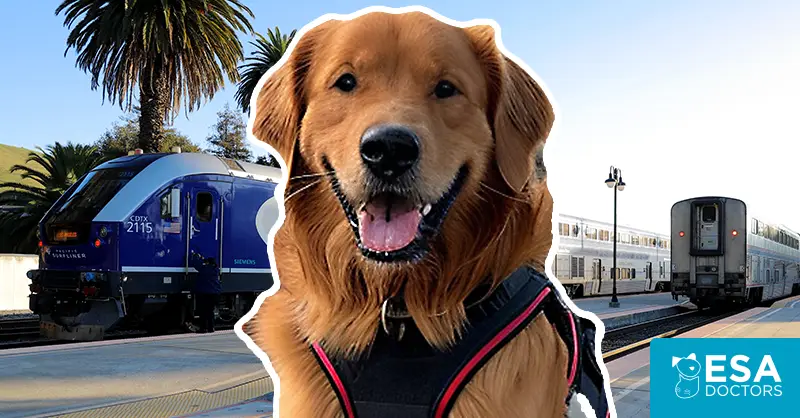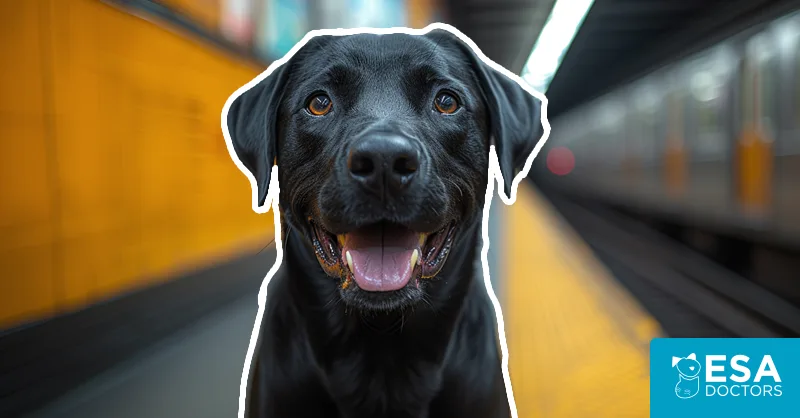Embarking on a train journey with your furry companion in the U.S. can be an exciting adventure for both of you. Trains can offer a more relaxed travel experience than visiting airports and include some fantastic views along the way, making them an ideal choice for pet owners.
This guide aims to enhance your preparation and ease any concerns, ensuring a smooth and enjoyable trip by rail for you and your dog.
Amtrak’s Dog-Friendly Policy
Amtrak warmly welcomes dogs up to 20 pounds (including the weight of their carrier) on most routes for journeys up to seven hours, with certain exceptions. Note that restrictions apply for routes in Canada, such as the Adirondack, Maple Leaf, and Amtrak Cascades, as well as the Auto Train, San Joaquins, and Thruway Connecting Services in the U.S. Be sure to double-check ahead of time to make sure your route doesn’t exclude dogs.
Dogs must be at least eight weeks old, odorless, harmless, and not disruptive. Passengers must also certify that their dog is up to date on all vaccinations and sign a pet release and indemnification form.
Amtrak Dog Fees
Many pet owners have also taken a renewed interest in train travel after airlines stopped allowing emotional animals and larger dogs on planes. Taking a dog on a plane can also be costly, with some airlines charging $125 each way for one dog.
Trains can present a less stressful alternative to flying, offering the comfort of your pet’s presence right by your side throughout the journey. Amtrak sets a relatively affordable fee of just $29 or $39, depending on the route you take, making train travel an economically attractive option.
Selecting the Right Pet Carrier for Amtrak
On Amtrak, pet carriers, whether hard or soft-sided, must be leak-proof, well-ventilated, and have a maximum size of 19″ x 14″ x 10.5″. Amtrak will count the carrier as one piece of carry-on luggage. Each carrier should accommodate only one dog and ensure their comfort and safety, allowing them to sit, lie down, and stand without touching the carrier’s sides.
Emotional Support Animals and Service Dogs on Amtrak
Unlike officially trained service dogs, which have broad access rights under the Americans with Disabilities Act, ESAs are not universally permitted to accompany their owners in all public spaces, including trains. Amtrak does not make any special accommodations for emotional support animals – they will be treated as normal pets.
Amtrak does, however, recognize service dogs and psychiatric service dogs. Service dogs can board Amtrak trains without charge and are not subject to the 20-pound weight limit. Service dogs must be under their handler’s control at all times. Service dogs are allowed to sit under the passenger’s seat or at their feet. They cannot block the aisle or occupy seats or beds.
Make sure to notify Amtrak ahead of time if you are traveling with a service dog. They may be able to reserve an accessible seat or space for you and your service dog.
Walking Your Service Dog While Traveling on Amtrak
If the train schedule permits, Amtrak may allow you to walk your service dog during station stops, as long as you stay close to the train and promptly board when the conductor notifies you that the train is about to depart.
Amtrak advises handlers to notify the conductor after first boarding if they plan to walk their dog during the journey. Many routes have no stops (or very short stops), so be sure to research in advance and give your dog ample opportunity to relieve itself before boarding the train.
Pre-Travel Considerations
Motion Sickness and Comfort
Just as some people experience motion sickness, the same can be true for pets. Consider taking a few shorter train trips to see how your pet copes before committing to a longer journey. Keeping them hydrated is crucial, especially if motion sickness arises.
Behavioral Readiness
Since most train operators require pets to be in carriers, it’s important to acclimate your pet to spending time in one well ahead of your trip. Disruptive behavior, such as continuous barking, may not be tolerated, making train travel unsuitable for some pets.

Health and Documentation
While local train services might not request pet health documents, Amtrak requires owners to sign a pet release and indemnification form attesting to their pet’s up-to-date vaccinations. Interstate travel may necessitate a Certificate of Veterinary Inspection (CVI), showing your pet is free from rabies and other diseases.
Service Dog Accessories for Train Travel
Many passengers and Amtrak staff are unaware of your service dog’s status and may wonder why your dog is not in a carrier or over the size limit. If your dog is a service dog, consider outfitting it with a service dog vest, ID card, or tags to avoid potential misunderstandings. These items signal to other passengers, Amtrak staff, and the conductor that your companion is not a typical pet. Amtrak does not require them, but most service dog handlers use them for their practical benefits.
Identification and Safety
Microchipping your pet increases the chances of reunification if they get lost. Additionally, ensure your pet wears a collar with your contact information.
Veterinary Preparedness and Relief Breaks
Identify the nearest vet along your travel route in case of emergencies. For longer journeys, check if any stops for relief breaks will be available during the trip.
Ideal Amtrak Routes for You and Your Dog
Embarking on a scenic train journey with your canine companion can be one of the most memorable experiences you can share. When considering Amtrak routes that are ideal for traveling with dogs, you’ll want to look for those offering breathtaking views and comfortable durations.
The Pacific Surfliner route, for example, winds along the picturesque California coastline, providing stunning ocean views that you and your pet can enjoy from the comfort of your seat.
Another excellent choice is the Adirondack route, which travels through the lush landscapes of New York and into Montreal. It offers panoramic views of the mountains and lakes that are sure to captivate.
For those in the Midwest, the Empire Builder route presents an unparalleled opportunity to witness the majestic beauty of the Pacific Northwest, traversing through mountains, forests, and the beautiful northern plains.
Each of these routes offers visual treats, and features stops in dog-friendly cities where you can stretch your legs and explore with your furry friend during longer layovers. Choosing a route that combines the serenity of nature with the convenience of travel-friendly stops makes for an ideal journey for you and your dog, creating lasting memories and a deeper bond as you explore new landscapes together.
Train travel can offer a more relaxed environment for pets, with scenic vistas along the way, as opposed to the potential stress of air travel. Preparing thoroughly by considering your pet’s comfort, behavior, and health requirements can ensure a pleasant journey for all.
Need a PSD letter from a licensed therapist?
See if you have a qualifying disorder for a PSD by clicking below.



Can I travel this way with my dog..11lbs.. from columbia, SC to Boston, MA?
THANK YOU
If your dog is a service dog, that should be allowed by Amtrak.